Papers by Daniel Felsenstein
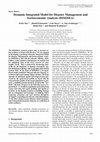
Journal of Disaster Research, 2018
The DIM2SEA research project aims to increase urban resilience to large-scale disasters. We are e... more The DIM2SEA research project aims to increase urban resilience to large-scale disasters. We are engaged in developing a prototype Dynamic Integrated Model for Disaster Management and Socioeconomic Analysis (DIM2SEA) that will give disaster officials, stakeholders, urban engineers and planners an analytic tool for mitigating some of the worst excesses of catastrophic events. This is achieved by harnessing state-of-the-art developments in damage assessment, spatial simulation modeling, and Geographic Information System (GIS). At the heart of DIM2SEA is an agent-based model combined with post-disaster damage assessment and socioeconomic impact models. The large amounts of simulated spatial and temporal data generated by the agent-based models are fused with the socioeconomic profiles of the target population to generate a multidimensional database of inherently “synthetic” big data. Progress in the following areas is reported here: (1) Synthetic population generation from census tract ...
Promoting Local Growth, 2019

Spatial Economic Analysis, 2021
This editorial summarizes the papers published in issue 16(3) (2021) in order to raise the bar in... more This editorial summarizes the papers published in issue 16(3) (2021) in order to raise the bar in applied spatial economic research and highlight new trends and knowledge. The first paper analyses the economic consequences of the rise and spread of the Covid-19 virus in the Brazilian state of São Paulo. The second paper presents a multi-regional generalized RAS technique to update input–output tables. The third paper investigates which European Union regions are most likely to be exposed to external shocks and which are more resilient. The fourth paper proposes a new neighbourhood inequality index for cities. The fifth paper analyses productivity and profitability using a sophisticated hierarchical model applied to a huge data set of individual firms. The sixth paper contains an empirical analysis on the choice of the national capital city location among 80 potential candidates in China over a period of 2240 years. The seventh paper explains political ideology at the municipality le...

International Regional Science Review, 2020
Informed regional policy needs good regional data. As regional data series for key economic varia... more Informed regional policy needs good regional data. As regional data series for key economic variables are generally absent whereas national-level time series data for the same variables are ubiquitous, we suggest an approach that leverages this advantage. We hypothesize the existence of a pervasive “common factor” represented by the national time series that affects regions differentially. We provide an empirical illustration in which national FDI is used in place of panel data for FDI, which are absent. The proposed methodology is tested empirically with respect to the determinants of regional demand for housing. We use a quasi-experimental approach to compare the results of a “common correlated effects” (CCE) estimator with a benchmark case when absent regional data are omitted. Using three common factors relating to national population, income and housing stock, we find mixed support for the common correlated effects hypothesis. We conclude by discussing how our experimental desi...
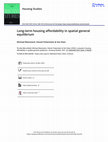
Housing Studies, 2020
We argue that housing affordability is as much about incomes as it is about house prices. Consequ... more We argue that housing affordability is as much about incomes as it is about house prices. Consequently, a comprehensive analysis of housing affordability should be conducted in which incomes and house prices are determined through the specification of labor, capital and product markets in addition to housing markets. A spatial econometric model for Israel is used to study the effects on the regional distribution of housing affordability of income generating shocks in labor and capital markets, as well as supply shocks in housing markets. Particular attention is paid to the effects on affordability of planning delays in tendering land for housing construction and the issue of building permits. Spatiotemporal impulse responses for housing affordability show that region-specific shocks, such as accelerated planning permission and the provision of regional investment grants, percolate across the economy as a whole. Implications for place-based regional policy are discussed.
Spatial Economic Analysis, 2020
In addition to the three special issue papers, issue 15.1 contains two papers on input-output ana... more In addition to the three special issue papers, issue 15.1 contains two papers on input-output analysis. The first paper provides a thorough analysis of the cross entropy (CE) method to build input-output tables at subterritorial levels or to update them in time. The second paper proposes a spatial input-output location quotient accounting for the co-location of related industries within the same area and for spatial spillovers of concentration into neighboring areas.
International Journal of Disaster Risk Reduction, 2020
This is a PDF file of an article that has undergone enhancements after acceptance, such as the ad... more This is a PDF file of an article that has undergone enhancements after acceptance, such as the addition of a cover page and metadata, and formatting for readability, but it is not yet the definitive version of record. This version will undergo additional copyediting, typesetting and review before it is published in its final form, but we are providing this version to give early visibility of the article. Please note that, during the production process, errors may be discovered which could affect the content, and all legal disclaimers that apply to the journal pertain.
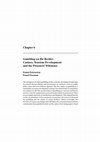
The emergence of casino gambling on the economic development landscape has forced elected officia... more The emergence of casino gambling on the economic development landscape has forced elected officials and practitioners to confront a host of public policy issues that were hitherto ignored. The first relates to gambling as a sustainable economic development strategy. For which kinds of community is it suited, if at all? The second relates to gambling as a tourism and leisure activity. Can it be categorized as such and under which circumstances? These are not simply questions of classification and definition. They depend heavily on the circumstances of the community in question, the sources of demand for gambling and the supply of casino facilities. Almost overnight, the fortunes of casinos can change and with them, the economic futures of those communities that gambled heavily on the casino; from being export-based 96 Chapter 6 economic development activities serving external demand in a regulated or monopolistic environment, they can turn into local service-based activities in a rut...

Tourism Economics, 1998
Gambling is intuitively considered as part of the tourism ‘package’. This paper empirically asses... more Gambling is intuitively considered as part of the tourism ‘package’. This paper empirically assesses this perception in the context of actual casino development in Indiana and simulated impacts of a hypothetical casino in Israel. In both contexts, the sources of demand for gambling, the extent to which these are ‘tourist’ sources and the question of gambling-generated demand displacing existing tourist demand, are examined. Despite the rather different market and political contexts in Indiana and Israel, the findings on the gambling-tourism relationship and the effect of gambling on local economies, are remarkably consistent. In both cases, gambling is seen to be grounded in import-substitution rather than pure ‘export’ activity. Additionally, in both cases there is evidence that the introduction of gambling displaces tourist demand. The policy implications of these findings point to the need to differentiate between local and national impacts of gambling and between the local fisca...
Employment Research, 2004
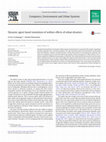
Computers, Environment and Urban Systems, 2016
An agent based model for assessing the welfare impacts of urban disasters is presented. This coup... more An agent based model for assessing the welfare impacts of urban disasters is presented. This couples a population allocation algorithm with a simulation platform. The fully articulated model fuses both bottom-up (locational choice for workplace, residence and daily activities) and top-down (land use and housing price) protocols. This study moves beyond current research by addressing economic welfare consequences of urban disasters. The resilience capabilities of different income groups are identified. This is illustrated for the Jerusalem central business district. Empirical results at the micro-scale suggest that physical destruction leads to a zero-sum game within the housing market in which wealthier residents hold an advantage over the poor. This results in the transformation of neighborhoods and displacement of poor and vulnerable populations. Low income groups lose both physical ground and the social support systems that go with location. Policy implications of these findings are discussed.
International Journal of Manpower, 2015

Letters in Spatial and Resource Sciences
This paper investigates the polarizing effect of FDI on regional earnings in host nations. A key ... more This paper investigates the polarizing effect of FDI on regional earnings in host nations. A key hypothesis is that the link between FDI and regional inequality is mediated by regional capital-labor ratios. In the absence of regional FDI data, a method for estimating the effects of FDI on regional inequality is proposed in which national FDI is hypothesized to be a common factor for regional capital investment. Empirical analysis of regional panel data for Israel shows that regional capital stocks vary directly and heterogeneously with the stock of national FDI, and that regional earnings vary directly and homogeneously with regional capital-labor ratios. These two relationships are used to calculate the contribution of FDI to regional earnings inequality over time. We find a substantial polarizing effect. Between 1988 and 2010 the variance of log regional earnings increased from about 0.011 to 0.025. More than half of this increase may be attributed to the polarizing effects of FDI. Policy implications of these findings are discussed.
This article appeared in a journal published by Elsevier. The attached copy is furnished to the a... more This article appeared in a journal published by Elsevier. The attached copy is furnished to the author for internal non-commercial research and education use, including for instruction at the authors institution and sharing with colleagues. Other uses, including reproduction and distribution, or selling or licensing copies, or posting to personal, institutional or third party websites are prohibited. In most cases authors are permitted to post their version of the article (e.g. in Word or Tex form) to their personal website or institutional repository. Authors requiring further information regarding Elsevier’s archiving and manuscript policies are
Advances in Spatial Science, 2019
Advances in Spatial Science, 2005
Ahmad, Nuzhat, 1691 Kloosterman, Robert C., 1325 Alexander, Carol, 1667 Allen, Chris, 1451 Altaf, Mir Anjum, 1763 Asabere, Paul K., 1777 465 Dorling, Daniel, 181 Dowall, David E., 1497 Dowding, Keith, 769 Dunham, Philip J., 1279 Dushnisky... more Dorling, Daniel, 181 Dowall, David E., 1497 Dowding, Keith, 769 Dunham, Philip J., 1279 Dushnisky, Kelvin, 99 Emmi, Philip C., 1117 Esparza, Adrian, 29 Evans, Alan W., 1777 Fagnani, Jeanne, 921 Faludi, Andreas, 485 Fan, Ming, 1625 Felsenstein, Daniel, 867 Fielding, AJ, 679 Fingleton, Bernard, 47 Ford III, Coit Cook, 835 Gentle, Christopher, 181 Gibb, Kenneth, 1481 Gilbert, Alan, 605 Grieco, Margaret, 1517 Hamnett, Chris, 357, 401 Hart, Tom, 705 Healey, Michael J., 1279 Hegedus, J6zsef, 989 Hill, Edward, 835 Hoggart, ...

Journal of Official Statistics, 2021
We draw attention to how, in the name of protecting the confidentiality of personal data, nationa... more We draw attention to how, in the name of protecting the confidentiality of personal data, national statistical agencies have limited public access to spatial data on COVID-19. We also draw attention to large disparities in the way that access has been limited. In doing so, we distinguish between absolute confidentiality in which the probability of detection is 1, relative confidentiality where this probability is less than 1, and collective confidentiality, which refers to the probability of detection of at least one person. In spatial data, the probability of personal detection is less than 1, and the probability of collective detection varies directly with this probability and COVID-19 morbidity. Statistical agencies have been concerned with relative and collective confidentiality, which they implement using the techniques of truncation, where spatial data are not made public for zones with small populations, and censoring, where exact data are not made public for zones where morb...
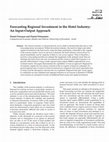
The tourism industry is characterized by severe shifts in demand that play havoc with forecasting... more The tourism industry is characterized by severe shifts in demand that play havoc with forecasting future investment. Within the tourism industry, the need for large-scale initial capital investment in the hotel sector, make the latter particularly vulnerable to the vagaries of the tourism market. Given an up-turn in demand, the hotel industry cannot always re-spond immediately and its' response is likely to vary across regions. There is therefore a need for a forecasting tool that can estimate the magnitude of the demand 'push' that can stimulate the hotel sector into new investment and the extent to which this response is re-gionally differentiated. Using a multi-regional input output (MRIO) augmented by an in-vestment matrix, this paper demonstrates the capabilities of such an approach. Regional ho-tel industry outputs for four classes of hotels in the six regions of Israel are estimated. Ex-pected regional rates of return to hotel investment are compared with actual (...








Uploads
Papers by Daniel Felsenstein